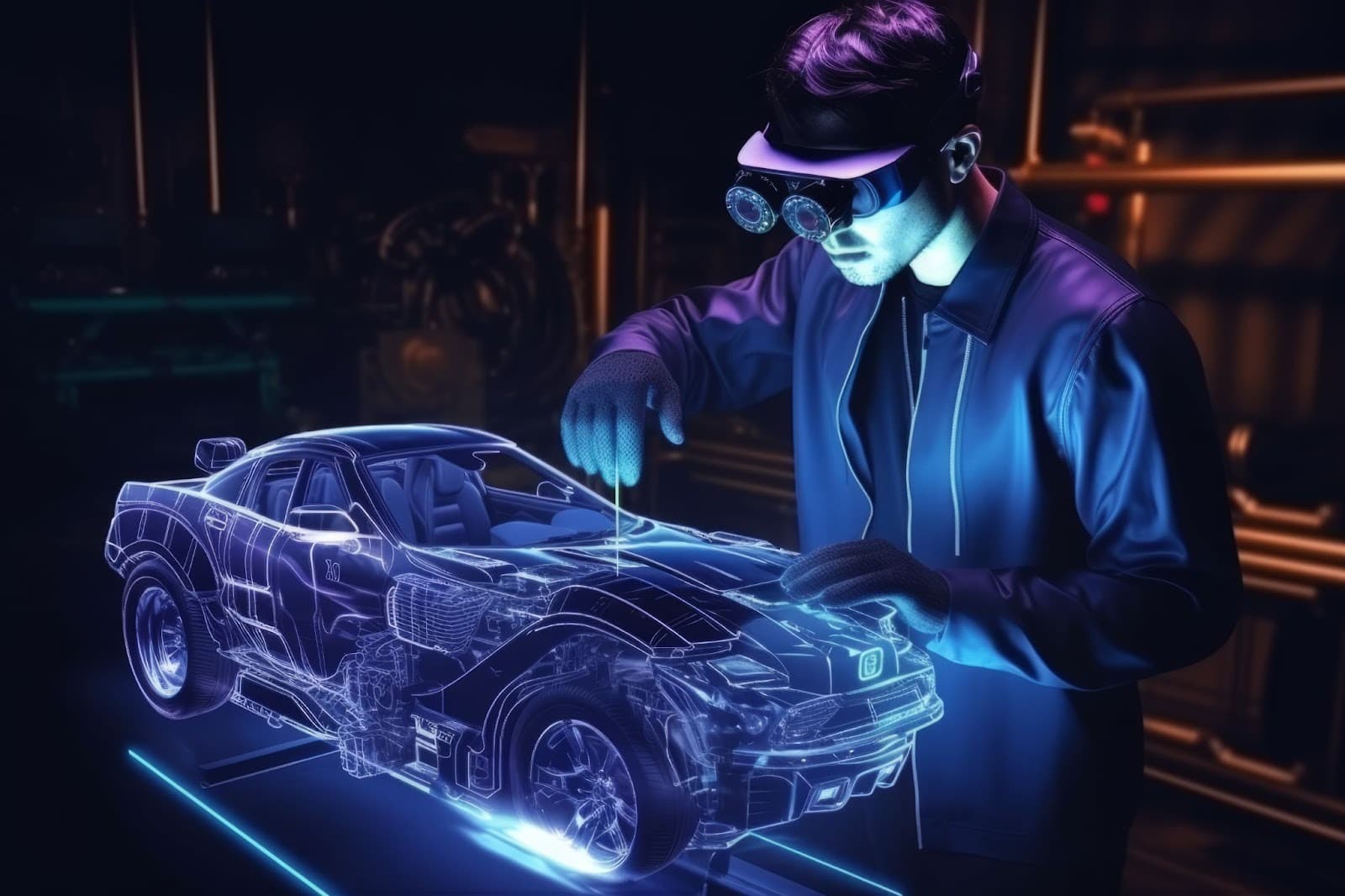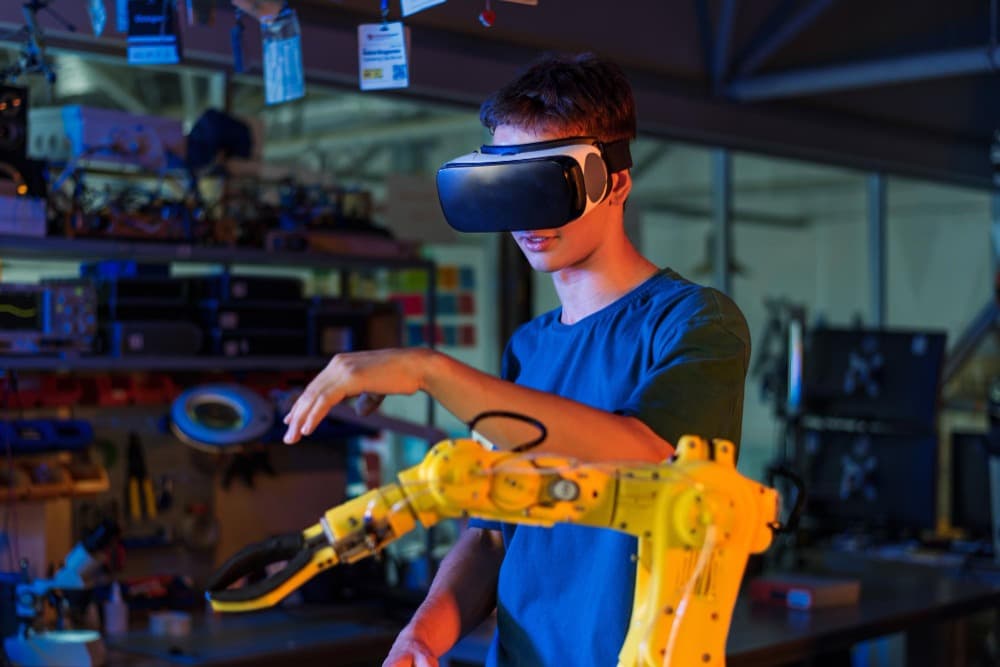Virtual Reality in Manufacturing: Benefits & Future Trends
A recent industry report estimates that the market for Virtual Reality in manufacturing was valued at USD 4.5 billion in 2023 and is projected to grow to nearly USD 39 billion by 2032. In response to competitive pressures, labor shortages, and rising consumer demands, U.S. manufacturers are turning to immersive digital technologies like VR to drive innovation, efficiency, and quality. This shift represents a major transformation from trial-and-error physical methods to virtual, data-driven workflows.
In this article, we will explore Virtual Reality in manufacturing, its current landscape, practical applications, benefits, adoption challenges, and the future role of VR in industrial operations.
What Is Virtual Reality in Manufacturing?
Virtual Reality in manufacturing refers to the use of computer-generated, three-dimensional environments that allow engineers, designers, and technicians to interact with virtual representations of real-world products, machinery, and processes. Using VR headsets, motion sensors, and simulation software, teams can experience every aspect of a design or production workflow in an immersive, lifelike setting.
This technology bridges the gap between digital design and physical production, enabling more accurate testing, faster iterations, and fewer costly errors. Unlike traditional computer-aided design (CAD) systems, VR offers an immersive manufacturing experience that helps users analyze ergonomics, assembly sequences, and production line efficiency from a first-person perspective.
The Current Landscape of Virtual Reality in Manufacturing
The adoption of Virtual Reality in manufacturing has surged over the last decade as digital transformation reshapes industrial operations. Once limited to research and design labs, VR is now being deployed on factory floors, training centers, and engineering workstations.
1. Growing Industry Adoption
A PwC report estimates that over 23 million jobs will use VR and AR by 2030, with manufacturing among the top five industries leading adoption. Companies like Ford, Boeing, and Siemens use VR to enhance design accuracy and streamline assembly processes. Immersive tools are cutting costs and improving product quality at every production stage.
2. Integration with Smart Manufacturing
VR now works alongside AI, IoT, and digital twin technologies to simulate production conditions in real time. Manufacturers can predict maintenance needs, reduce downtime, and optimize performance before physical testing. This integration supports the move toward fully connected, data-driven factories.
3. Workforce Training Transformation
With VR teaching tools, employees can practice machinery operations or safety drills in realistic virtual spaces. This eliminates training-related downtime and minimizes risk. It's also helping bridge the industrial skills gap by providing hands-on, scalable learning experiences.
4. Evolving Innovation Trends
Falling hardware costs and easier software integration are driving the adoption of VR in manufacturing across small and mid-sized firms. VR has moved from experimental technology to a mainstream manufacturing solution.
How Virtual Reality Is Being Used in Manufacturing
The applications of Virtual Reality in manufacturing extend across the entire production lifecycle, from concept design to maintenance. Its versatility enables manufacturers to enhance collaboration, optimize processes, and ensure worker safety.
1. Product Design and Virtual Prototyping

Engineers use VR to create and evaluate 3D models before a single part is physically built. This virtual prototyping process enables teams to identify potential design flaws, improve ergonomics, and reduce the number of costly physical prototypes.
2. Assembly Line Simulation
Manufacturers employ VR to simulate production lines, ensuring that workflows, equipment layouts, and worker movements are optimized for efficiency and safety. It also enables testing of different assembly configurations without disrupting existing operations.
3. Employee Training and Skills Development
VR is increasingly used as a teaching tool in workforce training. Employees can practice operating machinery, following safety procedures, and performing maintenance tasks in realistic virtual environments. This method not only improves learning retention but also reduces the risk of injury.
4. Quality Assurance and Maintenance
Technicians can use VR simulations to visualize internal machine components, diagnose defects, or conduct virtual maintenance routines. This improves accuracy and reduces downtime across production systems.
5. Remote Collaboration
VR connects global teams in shared virtual environments, enabling engineers, suppliers, and managers to review designs and discuss improvements in real-time. This supports remote work models and accelerates decision-making.
Benefits of Virtual Reality in Manufacturing
The benefits of Virtual Reality in manufacturing are both strategic and operational. By integrating immersive technologies into their workflows, manufacturers are unlocking new levels of efficiency, collaboration, and safety.
1. Faster Time-to-Market
Virtual prototyping allows companies to validate designs early and avoid production delays. This accelerates product launches and enhances competitiveness.
2. Cost Reduction
By minimizing physical prototypes, travel costs, and rework, VR helps manufacturers save significantly on materials and labor.
3. Enhanced Safety and Risk Mitigation
Training workers in VR reduces exposure to hazardous situations, promoting safer work environments and improving compliance with OSHA safety standards.
4. Improved Collaboration and Innovation
Cross-functional teams—designers, engineers, and operators—can interact with the same virtual model, enhancing communication and alignment across departments.
5. Sustainability and Waste Reduction
Virtual testing and simulation reduce resource consumption, aligning with sustainability goals and corporate environmental initiatives.
According to Deloitte Insights, organizations implementing VR-enabled digital twins have achieved a 15–20% reduction in rework and enhancements in their reassembly processes.
Virtual Reality Examples in Manufacturing
Real-world use cases across the manufacturing sector demonstrate how VR delivers measurable results:

1. Ford Motor Company: Virtual Assembly Simulations
Ford's Immersive Vehicle Environment (FiVE) enables engineers to evaluate new car designs using full-scale VR simulations. The system identifies ergonomic risks and optimizes assembly processes, saving millions in rework costs.
2. Boeing: Aircraft Design and Maintenance Training
Boeing integrates VR into aircraft design and technician training. Engineers use VR to visualize airplane wiring and cabin layouts, while maintenance teams practice procedures in virtual models, improving precision and safety.
3. General Electric (GE): Equipment Maintenance Simulations
GE integrates VR into turbine and engine maintenance simulations, allowing technicians to rehearse high-risk procedures virtually. This has reduced operational downtime and improved overall safety performance.
4. Lockheed Martin: Spacecraft Assembly Training
Lockheed Martin leverages VR for spacecraft assembly and astronaut training. Teams can interact with virtual spacecraft components, improving accuracy in assembly and ensuring flawless execution in high-stakes operations.
5. Caterpillar: Heavy Equipment Operation Training
Caterpillar integrates VR simulators to train operators on heavy machinery. Trainees experience real-world terrain and hazard scenarios in a safe, controlled environment, boosting safety and reducing training costs.
6. BMW Group, Collaborative Design and Review
BMW uses VR for cross-departmental design reviews. Designers and engineers collaborate in shared virtual spaces, testing ergonomics, visibility, and comfort before a prototype is built, accelerating design validation.
7. Honeywell: Industrial Workforce Development
Honeywell's Immersive Field Simulator trains industrial workers in realistic plant scenarios. The platform uses VR to replicate control rooms and field environments, enhancing safety awareness and reducing human error.
Why Use Virtual Reality (VR) in Manufacturing
In a competitive industrial landscape, incorporating Virtual Reality in manufacturing is no longer optional; it's strategic. Manufacturers use VR to gain faster insights, reduce risks, and improve collaboration across their value chain.
1. Streamlined Decision-Making
VR provides leaders and engineers with interactive 3D models that can be explored from every angle. This spatial understanding enhances decision-making accuracy, especially in design and layout planning.
2. Enhanced Workforce Performance
Using VR teaching tools, employees can learn complex procedures and handle equipment without halting production or risking safety. This accelerates training while maintaining productivity.
3. Improved Quality and Precision
Virtual prototyping helps detect design flaws early, ensuring products meet high-quality standards before reaching production. This reduces waste and improves customer satisfaction.
4. Remote Collaboration and Flexibility
With global teams and distributed supply chains, VR enables real-time collaboration from anywhere in the world. Engineers can walk through virtual factories together, improving communication and efficiency.
5. Competitive Advantage
Adopting VR signals technological leadership. Companies that implement immersive solutions attract clients seeking innovation and precision, thereby enhancing brand reputation in the B2B space.
Challenges of Adopting Virtual Reality in Manufacturing
Despite its apparent benefits, integrating VR into manufacturing presents several technical, financial, and cultural challenges. Understanding these obstacles is crucial for developing an effective adoption strategy.
1. High Initial Investment
Implementing VR solutions involves significant upfront costs for hardware, software, and custom application development. While long-term savings are substantial, smaller manufacturers may face budgetary constraints.
2. Integration with Existing Systems
VR must seamlessly integrate with CAD, PLM, and ERP systems to ensure workflow efficiency. Compatibility and data synchronization often require expert technical support and infrastructure upgrades.
3. Workforce Adaptation
Employees accustomed to traditional methods may resist new technologies. Ongoing education and leadership support are key to driving cultural acceptance.
4. Cybersecurity Risks
As VR systems store sensitive design and production data, robust cybersecurity measures are vital to protect intellectual property from unauthorized access.
5. Performance Limitations
VR experiences rely on high computing power and precision tracking. In industrial environments, lag or calibration errors can hinder user experience and accuracy.
The Future of Virtual Reality in Manufacturing
The future of Virtual Reality in manufacturing is defined by integration, intelligence, and accessibility. As hardware becomes more affordable and software capabilities expand, VR will evolve from a support tool into a standard operational technology.
1. AI and Predictive Modeling
Artificial intelligence (AI) will enhance VR applications by automating data analysis, predicting maintenance needs, and improving simulation accuracy. Manufacturers will be able to identify performance issues before they occur.
2. Digital Twins and Real-Time Analytics
VR combined with digital twin technology will allow manufacturers to monitor production systems virtually in real time, enabling proactive problem-solving and process optimization.
3. Industrial Metaverse Development
The rise of the industrial metaverse will allow manufacturers to collaborate in persistent, shared virtual environments, transforming everything from design reviews to supply chain coordination.
4. Accessibility for SMEs
As costs decline, small and medium-sized enterprises will be able to adopt VR tools without major infrastructure investments, driving industry-wide transformation.
Conclusion
Virtual Reality in manufacturing is revolutionizing design, training, and production by enabling smarter, safer, and faster operations. As VR merges with AI and digital twins, it's becoming the cornerstone of Industry 4.0 innovation, driving efficiency and competitive advantage for forward-thinking manufacturers ready to embrace the future of immersive industrial technology.
Step beyond traditional marketing and use Flam's immersive technology to tell your brand story in 3D and captivate your audience like never before.
Comments
Your comment has been submitted successfully!